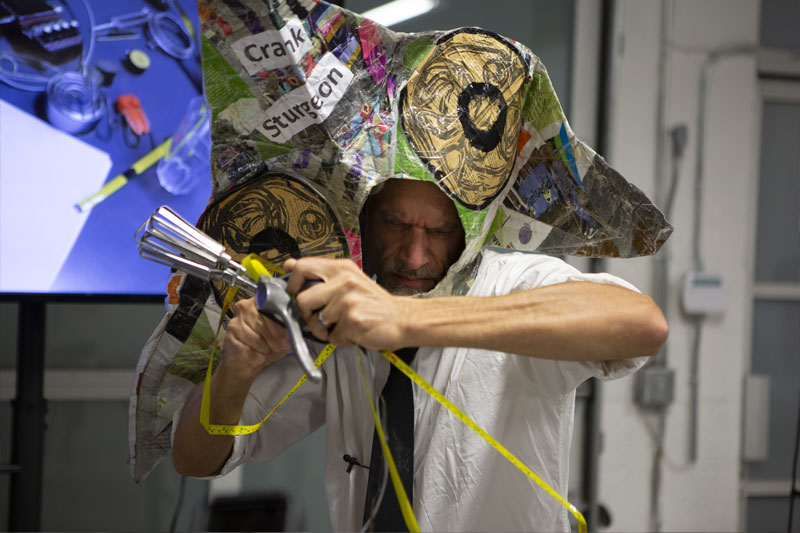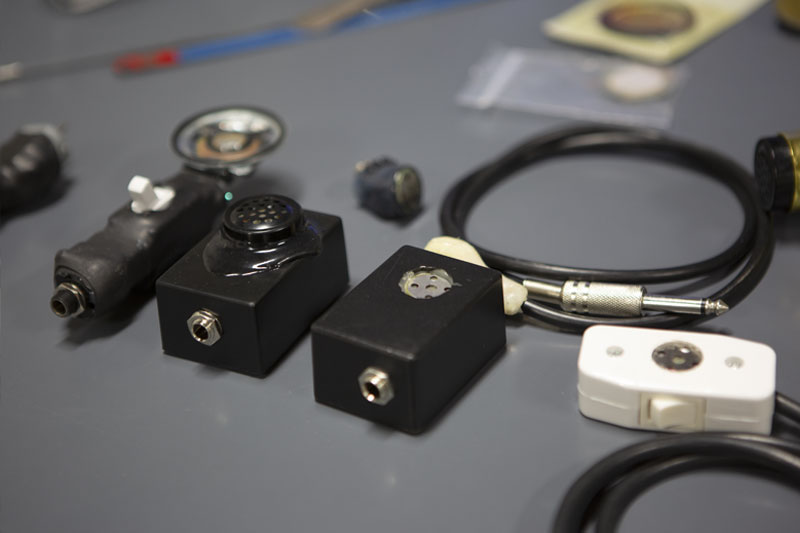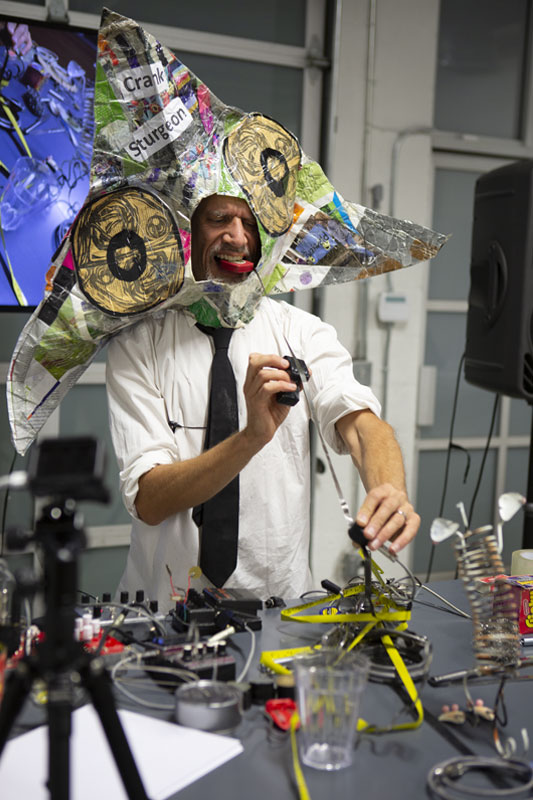Last week we were visited by a very special guest, who endowed our new event space with swarms of blissful noise extracted from some of the most common everyday objects. Crank Sturgeon is an artist first, yet he also makes fascinating sound-making objects available to other sonic explorers for use in their musical and non-musical applications. All of his inventions are hand-built with an endearing DIY aesthetic, and while they vary in shapes, forms, and sounds—all of them share a piezo-disc, an electromagnetic pickup, or a lo-fidelity microphone core, aimed toward amplifying anything-and-everything, thus promoting the idea of using our sense of hearing to explore the world around us.

In his uncommonly engaging performance, Crank Sturgeon sonified a garlic press, a whisk, some guitar strings, measuring tapes, paper, and in the most climactic part of his set demonstrated a particularly soulful hand-bowing solo on clear tape stretching a joyous smile on every face in the room as if this was also a part of his master plan.
After the performance, Mr. Sturgeon gave a thorough presentation of his work with explanations of what are contact and lo-fi microphones are and the infinite amount of creative ways they can be used to make sounds. We will try to summarize those ideas below as well as provide details about some of Crank’s self-made mics and instruments.
So What Is A Contact Microphone?
All microphones are, what we call, transducers—devices that convert one form of energy into another. Our typical condenser and dynamic microphones are designed to transform the vibration of molecules in the air into electrical signals. Contact microphones work on the same principle, but instead of converting air vibrations, they turn mechanical touch into electricity. They also tend to look different than a regular microphone, often taking the shape of a flat metallic disc with a layer of piezo crystal on top of it. Attaching a piezo mic on any surface allows one to amplify it, effectively opening up the possibility to turn pretty much any surface into a musical instrument. Also, as transducers tend to function bi-directionally, sending an electrical signal to the piezo mic turns it into a speaker, albeit a pretty quiet one.
It is quite common to use contact mics for amplification of acoustic instruments, like guitars and violins. Contact mics need to be amplified, and using standard pre-amplifiers built into mixers is usually enough.
In Crank Sturgeon’s collection, there are a couple standard piezo mics: Classic Contact Microphone with a ¼" output, and an XLR version of it, which provides a relatively cleaner signal and higher headroom.
Hydrophones
Hydrophones are microphones that can be submerged underwater, which is very useful when we want to spy on fish and other representatives of marine life.
The aforementioned piezo mics make excellent hydrophones, only requiring to be sealed in some material like plastic or silicone, which prevents water from entering the electrical path.
In this category, Crank Sturgeon offers a durable and aptly named Immersion Sturgeon. Open a can of soda, put a hydrophone in it, turn up the volume and get immersed in the sparky sonic texture filling the room.
Electromagnetic Pickups
As you know, we humans have a very limited scope of senses, and much of the things happening around us, we simply are not equipped to notice. Electromagnetic waves are among the multitude of things that are generally undetectable by us, yet we’ve discovered tools that make it possible to transform them into discernable sounds, and it couldn’t be simpler.
Essentially, electromagnetic pickups are comprised of a metallic core, and many layers of thin copper wire wrapped around it. These tools are excellent for sonic explorations as they uncover some very unique and unusual noises when moved around various electric appliances.
Crank Sturgeon’s Magnet Opus is designed exactly around this principle and serves as an excellent "circuit sniffer," unveiling all the secrets your fridge and laptop have been hiding from you.

Lo-Fi Microphones
By lo-fi microphones, we understand any non-piezo microphones that have a rather limited frequency range. For example, cheap telephone speakers make great lo-fidelity mics when the flow of electricity is reversed.
Crank has a few of these in his collection, varying in shapes and sounds, so pick and choose: Barky Box, Barky Box (Largemouth Edition), Town & Mouth Report.

Making Musical Instruments out of Random Objects
While all of these transducers are great on its own, and it can be immensely fun to move them across surfaces in search of new sounds, with some creative thinking they can be used as cores of musical instruments. Many of the devices created by Crank Sturgeon are exactly that. For example with Plank & Pluck you get a simple wooden bar with a bunch of springs, and a door hinge attached to it. A contact microphone inside amplifies the whole surface, essentially making it a pretty capable platform for foley or experimental sound design.
Similar in idea, Perpetual Spring Device is built out of an aluminum mint box. The sound palette here will be slightly different as metal is a much more resonant material than wood.
Yet another variation on the principle is the Bow Buddy. On this instrument, Mr. Sturgeon used stiff metallic rods as the main sound generators. While you can create sounds by simply plucking the rods, as the name suggests using a bow on them can provide very satisfying screeches, ready to be put into any horror film soundtrack.
We found great pleasure in watching Crank Sturgeon present and share his ideas on the process of sound design and performance with such simple but powerful tools. We hope that you as well were both entertained, and perhaps learned something new. If you have questions about contact and lo-fi microphones, or maybe want to share some of your own ideas on how to use them, feel free to comment below.











